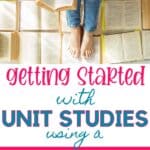Getting Started with Homeschool Unit Studies Using A Book Spine
The Fervent Mama uses Affiliate Links. See our disclosure policy here.
Points of interest (potent topics to study corresponding to subjects you have) can become the muscle and flesh of your homeschool unit study spine or framework.
It will be your task to gather materials, throw in a field trip, and use your creative genius to make your unit study one for the books.
In this post, I’m going to share some tips on creating a unit study using any book you already have as a unit study book spine or framework.
Are you ready for this? I’m sure you are!
A Homeschool Unit Study, Defined
First things first – what is a unit study?
Unit studies are time-specific overviews of a defined topic or theme that incorporate multiple subject areas into the study plan. Sometimes called “thematic units,” these studies often involve multisensory learning where each activity is organized according to the thematic idea.
The objective of unit studies is to allow students to delve deeply into a given topic so that they can gain mastery of it. By exploring a subject from multiple angles, information is more likely to be retained.
Time4Learniing.com
Wait! Don’t forget to pin it!

Unit Studies & Thematic Studies
Another name for a homeschool unit study is “thematic studies” because the individual lessons per subject revolve around a certain theme.
Think of the theme as the sun, and the points of interest/topics as the planets. They go around the sun, and they do not clash with the other planets!
Think of your structure as the orbits, and remember that while the planets are different from each other, they are harmoniously connected because of the reference point – the sun.
Knowing how to create your own homeschool unit study will help you engage your child where he is at.
When doing unit studies, it is good to determine the following:
1. Your child’s interests. – What fascinates your child?
2. Scope – What is included?
3. Time Limitation – When does it begin and end?
4. Plan of Execution – How do you implement your goal?
5. Progress Record – How do you measure success?
6. Conclusion/Assessment – How do you put everything together?
Unit Studies & Your Resources
Books are great foundations for unit studies. That said, you have to determine what books to use as your unit study book spine depending on your goal.
There are so many titles to choose from; classic novels, picture books, Bible storybooks, biographies. For starters, you can check out curated book lists to get a better idea of how to begin.
Needless to say, it’s nice to have a lot of books when you are homeschooling. But if you think you need help in this department, you can always visit your local library to borrow their books or check out online resources.
Let’s start with an example.
You first need your topic. For this one, we’ll use flowers as an example. We want to learn about flowers and we’ll use a classic that iis famous among homeschoolers.
It occupies famous homeschool booklists because of its various merits, such as watercolor illustration and great character.
If you guessed Miss Rumphius by Barbara Cooney, then you are right!
Just a quick note: As I talk about the different subjects, remember that I do this to guide you but I refrain from compartmentalizing. Unit studies are more effective, I believe, when the learner makes connections across the subjects.
Step-by-Step Unit Studies
For Character — explore a trait that is admirable and worthy of emulation. You can explore hope, a sense of adventure, creativity, patience, and initiative. You can copy some parts of the book that highlight these.
For Christian homeschoolers, we can read about the life of Dorcas for a simple comparative analysis. You may want to explore and highlight the ways in which Dorcas made the world a better place. How was she described in the Bible? Although the latter is fictional, Dorcas is a real Bible character.
Finally, to conclude the character and Bible lesson, we can guide the child to make a card (collage, watercolor, etc.) with a lupine design. Or, for the writing part, the child can write a personal essay about what he wants to be when he grows up.
Make a card that has a lupine design and write the Bible verse found in Acts 9:36.
Science, Art, Math, & Social Studies
For science, you can study the flower mentioned in the story. If you can, find a lupine seed, seedling, flower. Learn about the kind of soil it wants to grow in and the kind of weather it prefers.
Make a how-to journal or plant a lupine seed in your garden, or slip a lupine seed on one of your nature walks and visit the same spot next time to see what happens! Read this for tips.
For art, Draw a lupine. Experiment with the different colors that make up purple. Or, look for works of art that feature lupine flowers.
Research on the artist that made it and make your own version of the work of art you found. Imagine, if Vincent Van Gogh or Monet would use a lupine flower in their masterpiece, how would they show it?
For Math, you may set up a pretend flower shop where you will sell different kinds of flowers.
Create math problems with questions like “One pot of lupine costs 1.99. A customer handed the shopkeeper 10 dollars. She wants to buy 3 pots. How much is her change?
Make problems that will apply what your child is currently learning in math.
For Social Studies, you can explore what life is like in tropical countries. Name a tropical country and research about the kind of life they have. Know what they eat, what jobs they do, and what clothes they wear.
Draw a child wearing appropriate attire or what a typical breakfast for them looks like.
Pros and Cons of Thematic Studies
It’s easy to get excited about a unit study and forget that unit studies should not take too long to finish. Too many materials can be overwhelming especially if a child will do the study alone.
A certain degree of structure is needed so that the child knows the scope and sequence and can work alone if needed. Finally, know when to stop and start another one.
The pros of the unit study are that we can tailor-fit what we believe our child needs to learn under one theme. The level of student engagement is high because we are choosing material our children will most likely love or are interested in.
The cons, it is not easy to make. You will have to work on curating, connecting, and in some instances creating your materials to get the most out of your unit study.
That said, unit studies are fun if we know why we’re doing them, and when the child goes beyond the page of the spine to explore the vast domains of knowledge available.
So if you’re planning to make Unit Studies this year as a break from your boxed curriculum, you’re in the right place.
A big thank you to Ruth Solitario with Everything Happy Home for this guest post! You can also check out her resource page for more freebies and offers.

This is a contributed post for the 2021 How We Homeschool Series.
Learn more about the How We Homeschool Series, contributors, sponsors, and giveaways by heading here.























